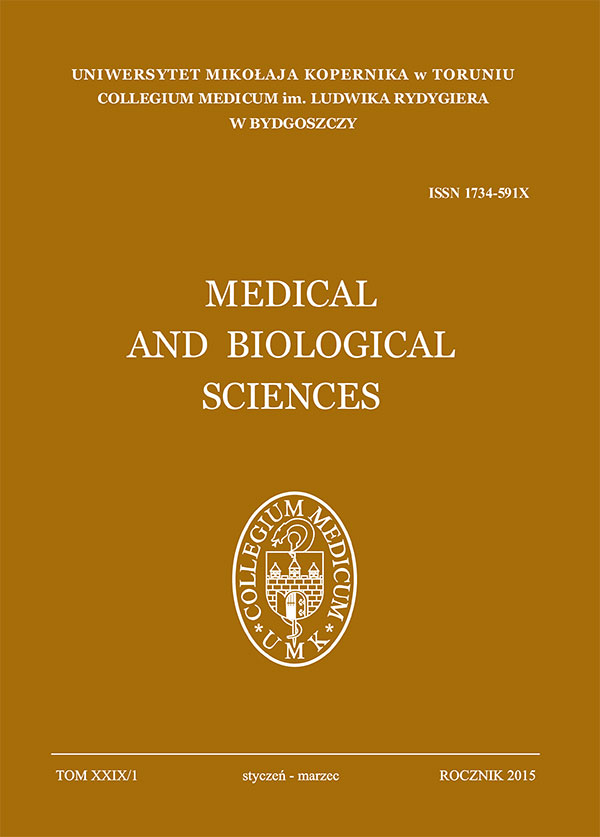Influence of rest breathing frequencies on the parameters of heart rate variability tachographs
DOI:
https://doi.org/10.12775/MBS.2015.003Keywords
heart rate variability, HRV biofeedback, resonance frequency, relaxation response, coherenceAbstract
The relaxation response is a method of overcoming stress factors. It is activated through slow breathing, which causes high heart rate variability. Higher heart rate variability increases the activity of parasympathetic nervous system causing organism to relax. The relaxation response is activated, when human organism achieves a state of inner balance, which is called the coherence. One of techniques to achieve this state of balance is breathing in the specific rhythm, which is usually around 0.1 Hz of frequency. This value is called the resonance frequency. In this study the activity of central nervous system in the specific range of breathing frequencies (0.07-0.12 Hz) has been checked in order to find an answer, if the relaxation response is triggered by one specific frequency or is there a specific range of breathing frequencies, which lead to the state of inner balance. In order to check the changes throughout human body the heart rate assessed by biofeedback technique has been used. It is a non-invasive method examining the function of sympathetic and parasympathetic nervous system through the changes in natural heart rhythm. Throughout the biofeedback sessions the resonance frequency is measured. The aim of this study was to check if there is a difficulty for subjects to maintain imposed breathing rhythm and if there is only one universal resonance frequency for everyone or is there a specified range. The study confirmed the difficulty of maintaining unnatural breathing frequency. It has also showed that there is a specific range of frequency values which can be used to achieve the coherence state.References
Telles S., Singh N., Joshi M., Balkrishna A., Post traumatic stress symptoms and heart hate variability In Bihar Floyd survivors following yoga: a randomized controlled study, BMC PSYCHIATRY 2011; 10:18
McCraty R., Atkinson M., Tomasino D., Bradley R. T., Emotions and heart rhythm patterns, Psychological Coherence, The Coherent Heart, Boulder Creek, California 2006; 7-14
McCraty R., Childre D., Coherence: Bridging personal, social and global health, ALTERN THER HEALTH M 2010; 16 (4) 10-24
Wanqing W., Yeongjoon G., Jungtae L., Combination of wearable multi-biosensor platform and resonance frequency training for stress management of the unemployed population, SENSORS 2012; 12 13225-13248
Lehrer P., Applied psychophysiology: Beyond the boundaries of biofeedback (mending a Wall, a brie history od our field and applications to control of the muscles and cardiorespiratory systems), APPL PSYCHOPHYS BIOF 2003; 28 (4) 291-304
Wheat A. L., Larkin K. T., Biofeedback of heart rate variability and related physiology: A critical review, APPL PSYCHOPHYS BIOF 2010; 35, 229-242
McCraty R. Tomasino D. Heart rythm coherence feedback: A New tool for stress reduction, rehabilitation and performance enhancement, HeartMath Research Center, Institute of HeartMath Boulder Creek, California, USA, 2004
Vaschillo E., Lehrer P., Rishe N., Konstantinov M., Heart rate variability biofeedback s a metod for assessing baroreflex function: A preliminary study of resonance in the cardiovascular system, APPL PSYCHOPHYS BIOF 2002; 27 (1) 1-27
Vaschillo E. G., Vaschillo B., Lehrer P., Characteristics of resonance in heart rate variability stimulated by biofeedback, APPL PSYCHOPHYS BIOF 2006; 31 (2) 129-142
Siepmann M., Aykac V., Unterdӧrfer J., A pilot study on effects of heart rate variability biofeedback in patients with depression and in health subjects, APPL PSYCHOPHYS BIOF 2008; 33 195-201
Terathongkum S., Pickler R. H., Relationships among heart rate variability, hypertension and relaxation techniques, JOURNAL OF VASCULAR NURSING 2004; 22, 78-82.
Travinen M., Niskanen J., Kubios HRV version 2.0 User’s Guide, Biosignal Analysis and Medical Imaging Group, Department of Physics, University of Kuopio, 2008.
Dusek A., Benson H., A model of the comparative clinical impact of the acute stress and relaxation responses, MINN MED 2009; 3, 47-50.
Krauze T., Guzik P., Wysocki H., Zmienność rytmu serca: aspekty techniczne, Nowiny lekarskie 2001; 70 (9) 973-984.
Viola A. U., Tobaldini E., Chellappa S. L., Casali K. R., Porta A., Montano N., Short term complexity of cardiac autonomic control Turing Steep: REM as a potential risk factor for cardiovascular system in aging, PLOS ONE 2011; 6 (4) 1-8.
Papp M., Lindfors P., Storck N., Increased heart rate variability but no effect on blond pressure from 8 weeks of hatha yoga – a pilot study, BMC RESEARCH NOTES 2013; 6 (59) 1-10.
Xu X. Y., Gao J., Ling D., Biofeedback treatment of prehypertension: Analyses of efficiency, heart rate variability and EEG approximate entropy, J HUM HYPERTENS 2007; 21, 973-975.
Buccelletti F., Bocci M. G.,Gilardi E., Linear and nonlinear heart rate variability indexes in clinical practice, COMPUT MATH METHOD M 2012; 1 1-5.
Downloads
Published
How to Cite
Issue
Section
Stats
Number of views and downloads: 666
Number of citations: 0



